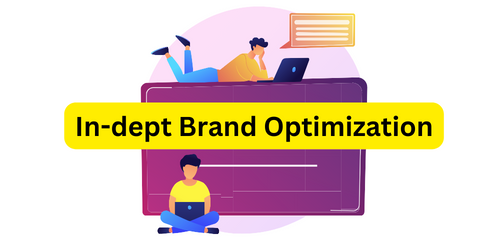In-Depth Brand Optimization: A Comprehensive Guide
In today’s competitive marketplace, a strong brand is more crucial than ever. A well-optimized brand creates a lasting impression on your target audience, fosters customer loyalty, and drives business success. However, achieving optimal brand performance requires a systematic and in-depth approach.
This guide provides a comprehensive overview of the key aspects involved in brand optimization, offering valuable insights and actionable steps.

Understanding Brand Optimization
Brand optimization means making your brand work better overall. It’s not just about how your brand looks; it’s about getting to the heart of what your brand is all about. This includes:
Brand strategy and positioning: Defining your brand’s core values, mission, vision, and unique selling proposition (USP) within the competitive landscape.
Brand identity and messaging: Crafting a consistent and compelling visual identity (logo, colors, fonts, etc.) and messaging that resonates with your target audience.
Customer experience: Ensuring a seamless and positive customer experience across all touchpoints, from initial interaction to post-purchase engagement.
Digital presence: Optimizing your website, social media channels, and online marketing strategies to maximize brand visibility and engagement.
Brand reputation: Building and maintaining a positive brand reputation through ethical business practices, transparent communication, and proactive reputation management.
Key Stages of In-Depth Brand Optimization
1. Brand Audit
- Conduct a thorough internal and external analysis of your brand, including market research, competitor analysis, customer surveys, and brand perception studies.
- Identify your brand’s strengths, weaknesses, opportunities, and threats (SWOT analysis).
- Evaluate your brand’s current performance against your goals and objectives.
2. Strategy Development
- Define your target audience and understand their needs, wants, and pain points.
- Articulate your brand’s unique value proposition and develop a clear positioning statement.
- Create a comprehensive brand strategy that outlines your long-term goals and objectives.
- Establish a brand identity that reflects your brand’s personality and resonates with your target audience.
3. Implementation and Execution
- Develop a brand implementation plan outlining specific actions and timelines for each element of your brand strategy.
- Ensure consistency across all touchpoints, including marketing materials, website, social media, and customer interactions.
- Integrate brand optimization into your overall marketing and business strategy.
4. Monitoring and Measurement
- Continuously monitor your brand performance using key performance indicators (KPIs).
- Track brand awareness, engagement, customer satisfaction, and other relevant metrics.
- Analyze data regularly and make adjustments to your strategy as needed.
Benefits of In-Depth Brand Optimization
- Increased brand awareness and recognition
- Improved customer loyalty and advocacy
- Enhanced brand reputation and trust
- Stronger competitive advantage
- Increased sales and revenue growth
- Improved employee engagement and morale
Tools and Resources for Brand Optimization
- Brand management software
- Customer relationship management (CRM) platforms
- Social media management tools
- Marketing automation platforms
- Design and editing software
- Data analytics tools
- Market research reports
- Brand consultancy services
Conclusion
In-depth brand optimization is an ongoing process that requires continuous commitment and effort. By implementing the strategies outlined in this guide and utilizing available tools and resources, you can effectively optimize your brand and achieve long-term success. Remember, a well-optimized brand is a powerful asset that can propel your business to new heights.


